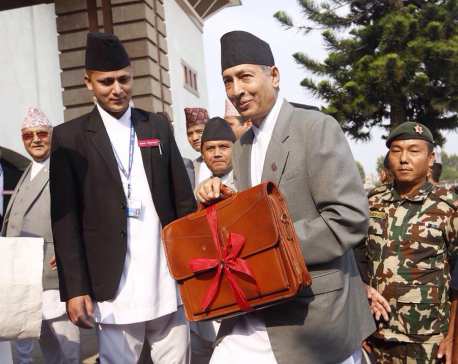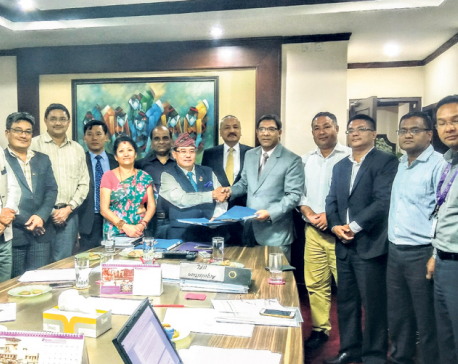
OR

More from Author
The study reveals that a key barrier to take-up of financial services is affordability, mainly due to irregularity and unpredictability of income
Nepal Rastra Bank in collaboration with UNCDF and other development partners is currently in the process of implementing the ‘UNNATI-Access to Finance Project’. This project is aimed at expanding financial excess of rural people and thus helping raise their living standards, with the ultimate goal of reducing overall poverty in Nepal. Under this project, Making Access Possible (MAP) diagnostic research was recently carried out to propose a roadmap for financial inclusion in Nepal.
Based on a nationwide Nepal FinScope Consumer Survey (2014), as well as on supply-side information gathered by interviewing regulators, financial service providers, and related stakeholders and associations, Nepal Financial Inclusion Roadmap is soon being released. This roadmap intends to provide guidelines and to serve as a resource for the government and other stakeholders to achieve greater financial inclusion in Nepal.
Main barriers
The study revealed that a key barrier to the take-up of financial services is affordability concern, mainly due to irregularity and unpredictability of income. Around 71 percent of adults noted their income is irregular, which makes it difficult for them to take up financial services, commit to regular payments and get access to credit.
Poor infrastructure, low literacy and high transportation cost prevent rural adults from accessing formal financial services. Branch networking is expensive and unable to reach the doorsteps of poor people. Lack of asset as collateral, procedural hurdles and absence of a registry to record collateralized assets create more obstacles to access credit.
Moreover, the easiness of tapping into informal markets and excess documentation requirements keeps adults from entering formal financial markets.
Financial products are mostly designed to serve the urban and semi-urban markets and are not keeping with the unique needs of the largely un-served rural markets. Lack of product innovation to meet the seasonal needs of the poor people is another barrier.
Absence of proper grievance-handling mechanism and lack of awareness about customer roles and responsibilities are other barriers. The target market lacks the knowledge and awareness of financial products, about how they work and benefit them. Increasing financial education and awareness is thus a big challenge.
The roadmap proposes an increase in “formal financial inclusion in Nepal from 60 percent to 75 percent by 2022” and reduction in the number of “the excluded from 18 percent to 3 percent”. In order to achieve this, the following actions are proposed.
Unlock credit
Based on the findings that 43 percent adults do not have saving accounts and that 54 percent adults have not borrowed either from formal or informal sector, unlocking constrained saving and credit market would help adult population generate large scale deposits and channel household cash in productive activities.
Barrier to savings are irregularity of income and poor level of income, so that there is not enough money to save, and lack of awareness on how deposit accounts are beneficial.
Looking at the saving behavior, 27 percent of adults claimed that they use banking products. The rest relied on cooperatives and other saving groups for savings.
Also, only 10 percent adults borrowed from banks, with the rest relying on cooperatives, saving groups and informal markets. Borrowing is not seen as important to their lives, nor for income-generating activities. High interest rates, fear of debts, and lack of knowledge of how borrowing works are the reasons for not borrowing.
Developing long-term saving products, reducing the cost of saving through digitization of financial services, developing products targeted at low-income markets, issuing non-collateralized products, improving business models by linking with locally-based service providers, strengthening credit information, and developing regulation to unlock credit and saving market are of priority.
Nepal is largely a cash-based economy and weak in payment infrastructure. Around 64 percent of adults use cash for transactions. Developing payment infrastructure, enabling regulatory framework and expanding branchless, mobile and internet banking are important too.
It is also important to improve the capability of adults to face risks. Only 28 percent of adults claim to be aware of insurance while 11 percent claim to have some form of insurance. Affordability is a key barrier. Increasing awareness of insurance among the general public is thus a big challenge going ahead. Improving insurer business models, product innovation to meet health and disaster risks and developing a favorable regulatory environment, among others, are important priorities as well.
Go local
Local formal and informal financial service providers can easily reach poor households and so leveraging their potential is important. So there needs to be a partnership between micro-finance institutions and local saving groups when it comes to developing financial products relevant to particular regions. Regulatory policies also need to support the expansion of formal banking system in remote areas.
Financial inclusion initiatives are best supported when driven by national policies and carried out by establishing institutional mechanisms involving the private sector. This calls for developing long-term financial inclusion framework, reviewing related policies and establishing supporting mechanisms to bolster financial inclusion activities in Nepal.
Educating and empowering consumers can be a key in driving up the demand for financial services. As about 25 percent of adults in Nepal are illiterate and the level of financial literacy is also low, raising the confidence and communication skills of this segment could also drive demand. Locally based financial services interactions would be the most effective in this.
Financial literacy initiatives thus have to be carried out in collaboration with financial service providers, government agencies, development partners and other formal and informal groups.
It has to be recognized that financial inclusion supports economic growth. Financial intermediation also helps with better distribution of capital and risks across the economy and thereby reduces poverty and inequality. At the micro level, it helps individuals improve their lives and encourages them to take up new economic activities.
The Monetary Policy for the fiscal year 2016/017 has given priority to financial inclusion, along with the release of Nepal Financial Inclusion Roadmap.
The challenge now is to develop long-term and short-term strategies, develop robust institutional mechanisms for coordination and implementation and establish a foolproof monitoring framework to ensure that a maximum number of Nepalis are enlisted into the formal financial regime.
The author is an Executive Director at Nepal Rastra Bank and oversees its Micro-Finance Promotion & Supervision Department
binodatreya@hotmail.com
You May Like This

Finance minister tabling first full-fledged federal budget shortly
KATHMANDU, May 29: Finance Minister Yubaraj Khatiwada is expected to try breathing new life into the economy, with his budget for... Read More...

Finance Ministry, NRB directed to open 'A-class' bank branch in all local levels
KATHMANDU, June 12: The Development Committee under the Legislature-Parliament has directed the Ministry of Finance and Nepal Rastra Bank (NRB)... Read More...

Civil Bank to acquire Unique Finance
KATHMANDU, Aug 2: Civil Bank Ltd (CBL) has announced that it was acquiring Unique Finance Ltd (UFL). ... Read More...




Just In
- Govt receives 1,658 proposals for startup loans; Minimum of 50 points required for eligibility
- Unified Socialist leader Sodari appointed Sudurpaschim CM
- One Nepali dies in UAE flood
- Madhesh Province CM Yadav expands cabinet
- 12-hour OPD service at Damauli Hospital from Thursday
- Lawmaker Dr Sharma provides Rs 2 million to children's hospital
- BFIs' lending to private sector increases by only 4.3 percent to Rs 5.087 trillion in first eight months of current FY
- NEPSE nosedives 19.56 points; daily turnover falls to Rs 2.09 billion
















Leave A Comment